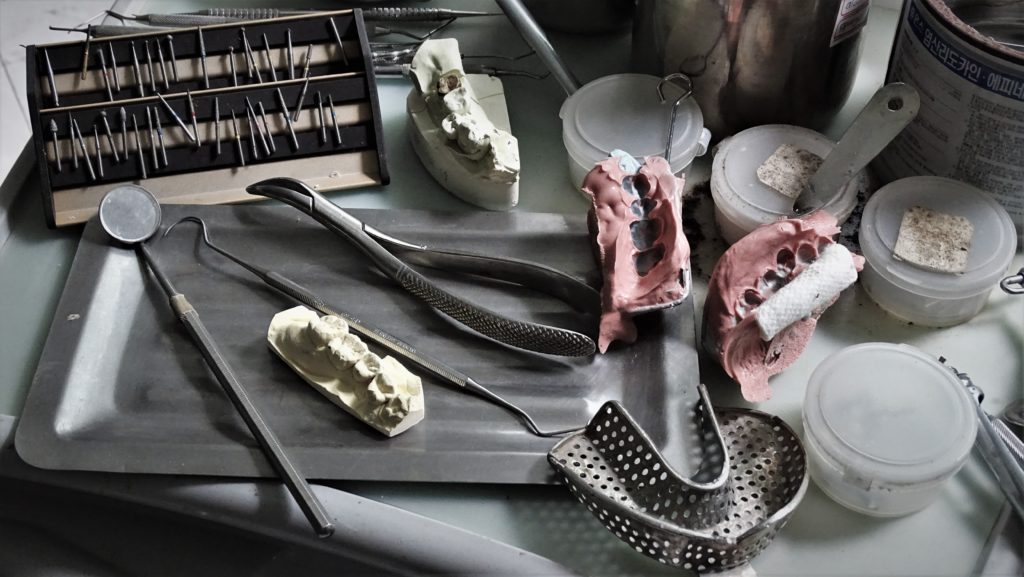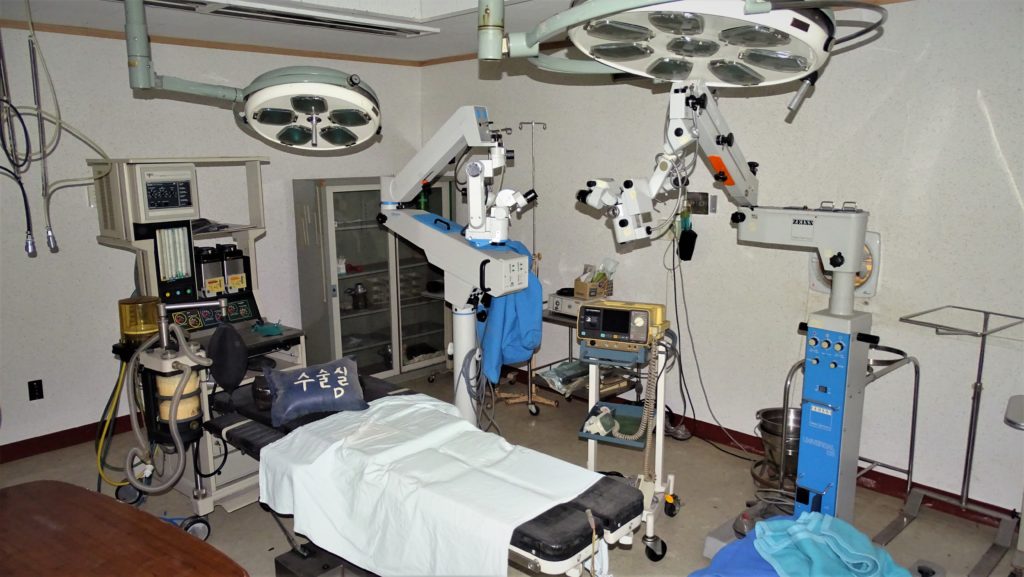Sorting Gwangju’s Cancer Jars: Day 2
Written and photographed by Isaiah Winters.
“What’s that, a silicone womb?”
“Yeah, and there’s a headless baby inside.”
“Weird. Here, lemme try on the breast vest now.”
– Two excited urban explorers
In last month’s article, a friend and I left off vowing to return to an abandoned hospital (this time with gloves) to continue sorting through hundreds of jars and pill bottles containing diseased human organs. And return we did. Safely back in what I’ve dubbed The Cancer Lab™, we wasted no time in setting the most freakish specimens back on nearby shelves and snapping tons of photos. Once we were satisfied with our morbid photoshoot, we hid these organs away to keep them from possible vandalism, which is unfortunately common at this particular location.

After closing up shop, we came across a large MRI room with all its bulky machinery still in place. In a corner were about a dozen large, specially made cases that caught our attention. To our morbid delight, inside were numerous medical training mannequins, ranging from entire bodies to individual body parts. Naturally, another photoshoot ensued, this one punctuated with guffaws of laughter whenever a new unboxing revealed some random inanimate body part. Spoiler Alert: If you’re squeamish about human anatomy, skip the next paragraph.

Many medical practice dummies and body parts are lined up for a photo shoot. One of the first silicone body parts to emerge was an episiotomy display (basically a vagina that has been surgically cut to ease childbirth). Trust me – don’t Google that. Along with this came a breast vest with shoulder straps, which, I’m ashamed to say, I tried on. A his-and-hers set of urethra displays also turned up, as did a CPR dummy with an oddly satisfied look on his face. Creepiest of all would have been the floppy facial skin of a child had we not found an open womb with a headless baby inside. Don’t Google that either.
Retiring from the MRI room and all its inanimate body parts, we headed to the pitch-black surgery rooms where so many of the jarred organs had likely been removed. We relied on our phone flashlights to catch sight of the lighting fixtures, surgical beds, machinery, and bundles of surgical kits, all of which had been left perfectly intact. Mold was a problem in a few of the rooms and the surgical kits were wrapped in horribly stained linens, but the machinery was in great shape. One such surgical kit had the words “Bone Cutter” scrawled across it in black marker, but the instrument inside, which looked like a dull pair of pliers, was rather disappointing when tested on nearby material.

Instruments sit unused in the hospital’s dental clinic.Next on our tour de mort was the emergency room, an obligatory stop at any abandoned hospital. Though badly vandalized, it still had lots to see. First to grab our attention was the iron lung located next to the X-ray room. Also known as a negative pressure ventilator, this tube-like chamber helped patients with diseases like polio that would paralyze muscle groups in the chest, making breathing difficult. Today it looks like something straight out of 1950s science fiction. Also interesting were the emergency room logs in which nurses and doctors would list the names and ailments of patients. Stretching back decades, the logs included everything from alcohol poisoning and amputation to the occasional red-lettered DOA (dead on arrival). Given this hospital’s closure due to low patient count, embezzlement, and falsification, we suspected that many of these entries might have been made up.
Unfortunately, I don’t think it’s right to share this hospital’s highly interesting backstory, as identifying it would lead to lots of dummies turning up and ruining this unusual find for cheap online likes. However, I can at least talk about my backstory in relation to it, for what it’s worth. My familiarity with this particular hospital goes back to 2013, when I first snuck onto the premises hoping to slip through unseen. The hospital’s security guard eventually spotted me anyway, at which point I put on my trademark “dumb foreigner face”™ to avoid escalating the situation. Seeing I meant no ill will, rather than berate me for trespassing, the guard invited me into his office to have coffee with him and his wife. There we sat and chatted for a while about why I’d come there, which was, in essence, to take only pictures and leave only footprints.

The best preserved surgery room was quite impressive.After gaining more of his trust, I was pleasantly surprised when he offered to show me his favorite part of the hospital. Accepting the offer, he guided me to a lush koi fish pond located in the inner courtyard. He said he took pleasure in feeding the large fish, that is, when he wasn’t busy catching intruders like me. Pressing my luck, I asked if he could show me other parts of the hospital, but he politely declined, at which point I thanked him and his wife and left. Out of respect, I didn’t return for a long time.

A skeleton and beakers sit in one of the hospital’s laboratories.Today this same office sits beneath layers of dust and shards of glass, the unfortunate results of time and vandalism. It was surreal reentering the place where, just a few years before, we’d sat cozily over cups of Maxim coffee. Remarkably, despite the increasingly ruinous state of the hospital, the koi fish pond is still thriving with lots of healthy-looking fish and clean water. Looking out over the tranquil scene, I couldn’t help but take a moment and wonder whatever happened to the guard and his wife. For all I know, they probably live nearby and continue to tend to the serene little pond. If my hunch is correct, I’d like to keep this little slice of heaven as pristine as possible for them, or for whoever still maintains it. It’s the least I can do.
The Author
Originally from Southern California, Isaiah Winters is a Gwangju-based urban explorer who enjoys writing about the City of Light’s lesser-known quarters. When he’s not roaming the streets and writing about his experiences, he’s usually working or fulfilling his duties as the Gwangju News’ heavily caffeinated chief proofreader.





